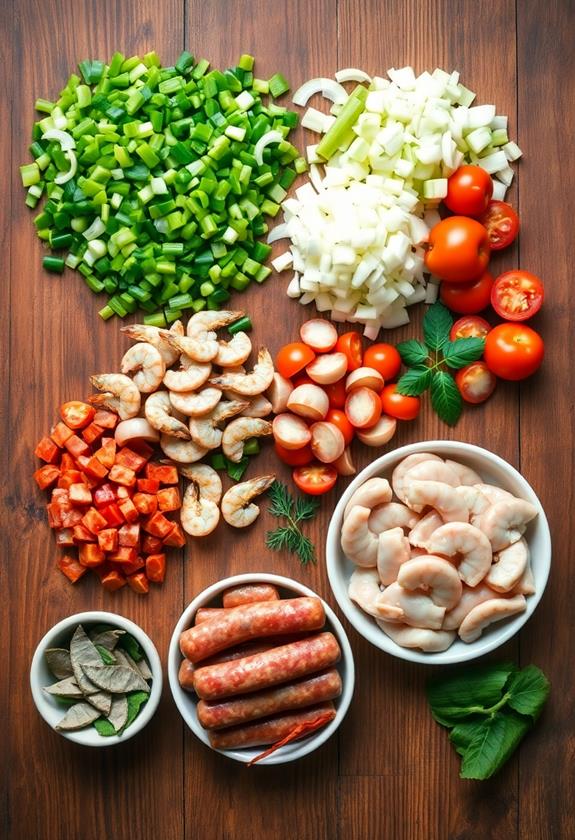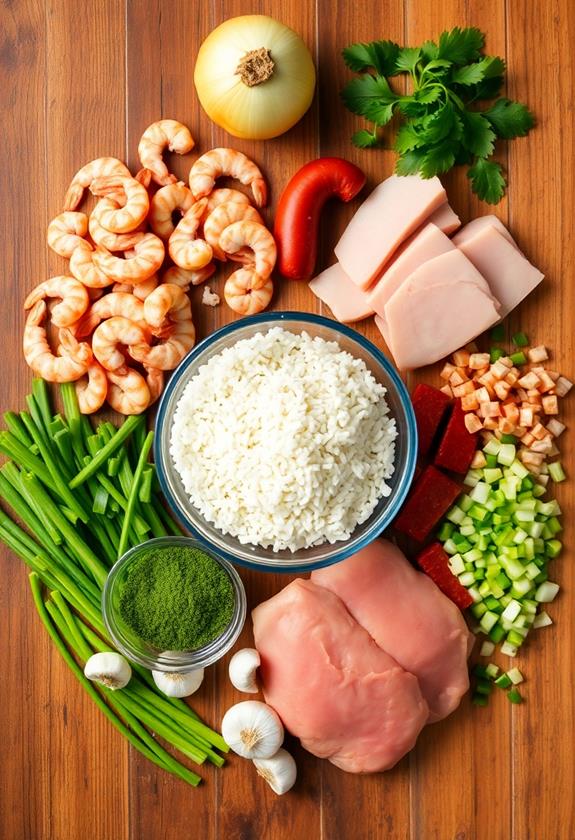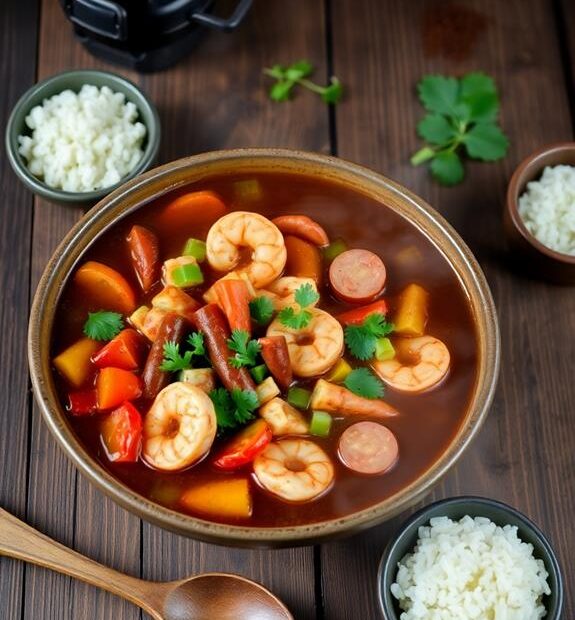Gumbo is a delicious stew from Louisiana, mixing seafood and sausage with a blend of unique flavors. Have you tried making it at home? At its heart, gumbo features a roux, formed by cooking flour and oil, giving it that rich, nutty taste. The "holy trinity" of veggies—onions, bell peppers, and celery—builds the flavor base. You can add shrimp, sausage, or chicken, customizing it to your liking! It's often served over rice and garnished with green onions. Trust me, letting it sit for a bit brings all those flavors together. Want to discover tips for making it even better?
History

Exploring the history of gumbo reveals its rich tapestry of cultural influences that shaped this iconic dish.
Originating in Louisiana in the 18th century, gumbo blends African, French, Spanish, and Native American traditions. Isn't it fascinating how food can tell a story? The diversity of cooking methods seen in dishes like gumbo mirrors the 6-in-1 functionality of Traeger grills, showcasing how culinary traditions evolve with technology.
The name "gumbo" likely comes from the African word for okra, "gombo," a key ingredient in many traditional recipes. Families created gumbo as a way to use what was locally available, leading to various styles across Louisiana.
You might wonder how this dish evolved so much.
Gumbo splits into two main styles: Cajun and Creole. Cajun gumbo often has a darker roux and skips tomatoes, while Creole gumbo includes them and has a lighter roux. Each style reflects the unique history and cultural heritage of its region.
Today, gumbo isn't just food; it's a celebration of Louisiana's vibrant culture. You'll find it at festivals, community gatherings, and competitions.
Recipe

Gumbo is a beloved dish that reflects the rich culinary heritage of Louisiana, combining influences from African, French, Spanish, and Native American cuisines. The heart of gumbo lies in its roux, a mixture of flour and fat cooked together until it reaches a deep, nutty color that adds complexity to the stew. The "holy trinity" of vegetables—onions, bell peppers, and celery—provides a flavorful base, while a variety of proteins such as andouille sausage, chicken, and seafood create a satisfying and hearty meal.
For those who enjoy BBQ, using tools like Bear Paws Meat Shredder Claws can make shredding meats for gumbo even easier, ensuring you have perfectly prepared ingredients for your dish.
Preparing gumbo is an art that requires patience and attention to detail, particularly when making the roux. The process can be time-consuming, but the depth of flavor achieved is well worth the effort. Once the gumbo is simmered to perfection, it's typically served over fluffy white rice and garnished with green onions and filé powder, creating a dish that's as visually appealing as it's delicious.
Ingredients:
- 1/2 cup vegetable oil
- 1/2 cup all-purpose flour
- 1 large onion, diced
- 1 green bell pepper, diced
- 2 stalks celery, diced
- 4 cloves garlic, minced
- 1 pound andouille sausage, sliced
- 1 pound chicken thighs, boneless and skinless, cut into pieces
- 1 pound shrimp, peeled and deveined
- 4 cups chicken stock
- 2 cups okra, sliced (optional)
- 2 bay leaves
- 1 tablespoon Cajun seasoning
- Salt and pepper, to taste
- Cooked white rice, for serving
- Chopped green onions, for garnish
- Filé powder, for garnish
In a large pot or Dutch oven, heat the vegetable oil over medium heat. Gradually whisk in the flour to create a roux, stirring constantly for 10 to 20 minutes until it reaches a deep chocolate-brown color.
Add the diced onions, bell peppers, and celery to the roux, cooking for an additional 5 minutes until the vegetables are softened. Stir in the minced garlic, sausage, and chicken, cooking until the chicken is browned.
Pour in the chicken stock, add the okra if using, bay leaves, Cajun seasoning, and season with salt and pepper. Bring the mixture to a simmer, then reduce the heat and let it cook for at least 30 minutes, stirring occasionally.
In the last 5 minutes of cooking, add the shrimp and cook until they're pink and opaque. Serve the gumbo over cooked white rice, garnished with chopped green onions and a sprinkle of filé powder.
When making gumbo, remember that the quality of your roux is key to achieving a rich flavor. Take your time and stir constantly to prevent burning.
You can also customize your gumbo by adding different proteins, such as crab or fish, or adjusting the spice level to suit your taste. For an even deeper flavor, consider letting the gumbo rest for a few hours or overnight before serving; the flavors will meld beautifully, making it even more delicious.
Final Thoughts

Creating a pot of gumbo is more than just cooking; it's about connecting with a vibrant culinary tradition that celebrates the flavors and culture of Louisiana.
When you immerse yourself in a gumbo recipe, you're embracing comfort food that warms both body and soul. The rich flavor of authentic gumbo comes from the perfect blend of ingredients, like the holy trinity of bell peppers, onions, and celery, combined with your choice of proteins, such as andouille sausage and shrimp.
To enhance your cooking experience, consider using a GreenPan Dutch Oven that promotes healthier meal preparation with minimal oil usage. Using a roux to thicken the stew gives it that signature texture everyone loves.
Have you ever experimented with different Cajun seasonings? They can elevate your gumbo to a whole new level!
Don't forget to use seafood stock for an added depth of flavor. Serve it over fluffy white rice, and you've got a meal that satisfies.

